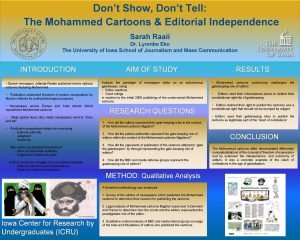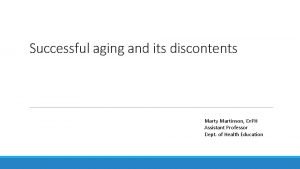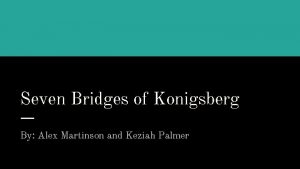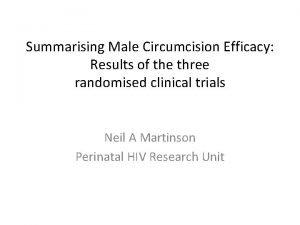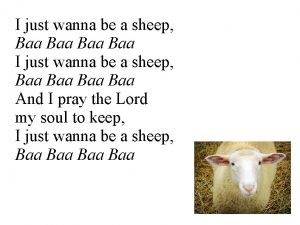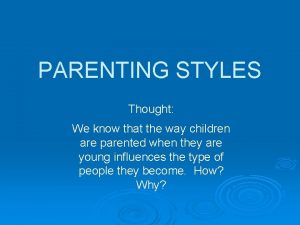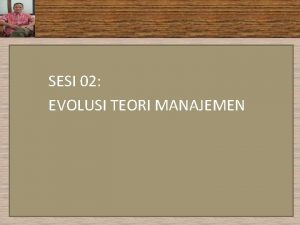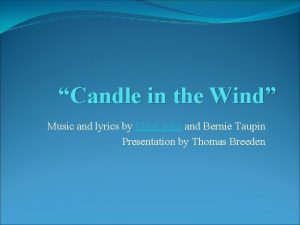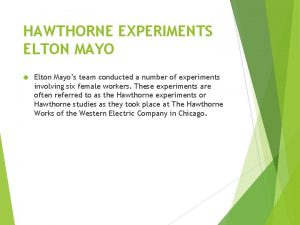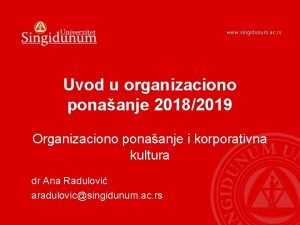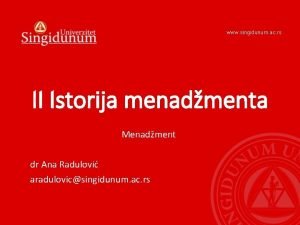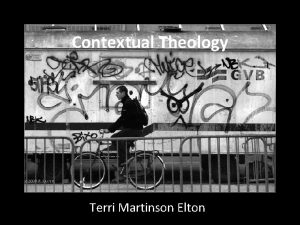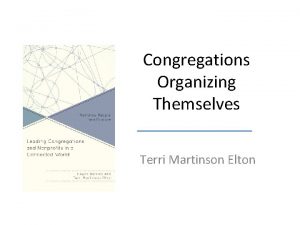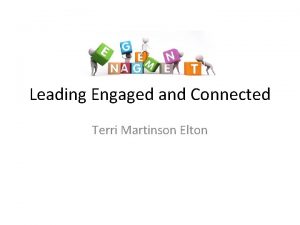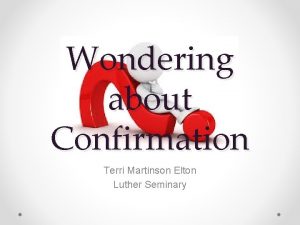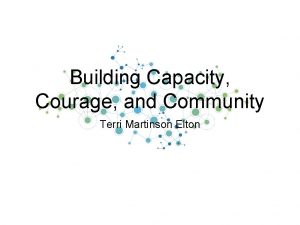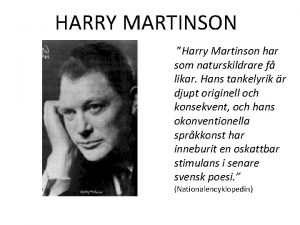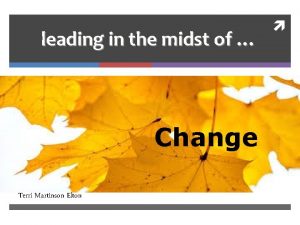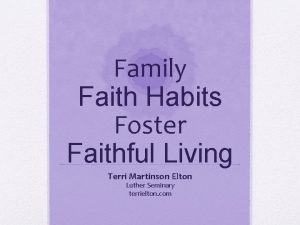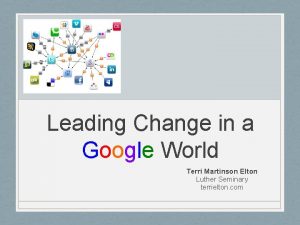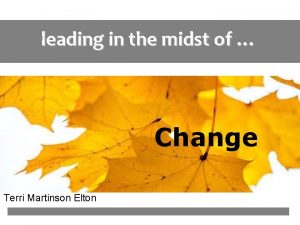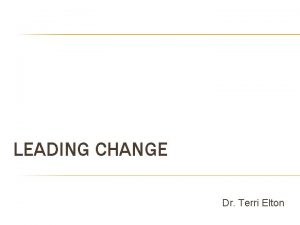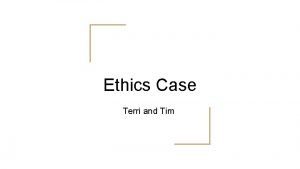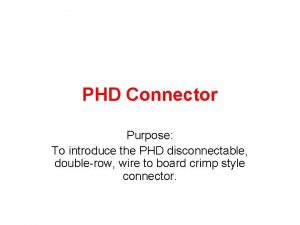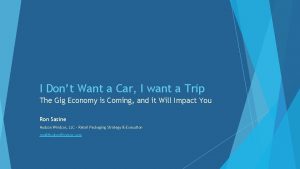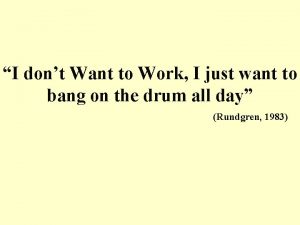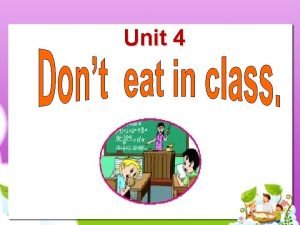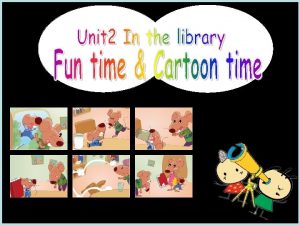terri martinson elton phd I dont want to


























- Slides: 26

terri martinson elton, phd

I don’t want to leave here I don’t want to stay It feels like pinching to me either way The places I long for the most Are the places where I’ve been They are calling after me like a long lost friend It’s not about losing faith It’s not about trust It’s all about comfortable When you move so much The place I wasn’t perfect But I had found a way to live It wasn’t milk or honey But then neither is this CHORUS: I’ve been painting pictures of Egypt Leaving out what it lacked The future seems so hard And I want to go back But the places that used to fit me Cannot hold the things I’ve learned And those roads closed off to me While my back was turned The past is so tangible I know it by heart Familiar things are never easy to discard I was dying for some freedom But now I hesitate to go Caught between the promise And the things I know BRIDGE: If it comes too quick I may not recognize it Is that the reason behind all this time and sand? If it comes too quick I may not appreciate it Is that the reason behind all this time and sand? Painting Pictures of Egypt




“The future of American religion is in the hands of adults now in their twenties and thirties. ” Wuthnow, After the Baby Boomers, 2

“young adults are not only the future of American religion; they are already a very significant part of it and because they have been overshadowed by the baby boomers, this current generation of younger adults is not very well understood, either by religious leaders or by scholars. The need for better information about young adults is thus urgent for the present as well as the future. ” Wuthnow, After the Baby Boomers, 2

Two things to keep in mind: How to Think about Young Adults…. the place of younger adult in our society and their role in social change. (Wuthnow, After the Baby Boomers, 3)

Coming of Age 1. Age – Life Expectancy Changing! Today the first half of adulthood= ages 21 to 45. People are living longer! Life Expectancy… In 1900 – 46. 3 for men and 48. 3 for women. In 1950 – 65. 6 for men and 71. 1 for women. In 1970 – 67. 1 for men and 74. 7 for women. In 2000 – 74. 3 for men and 79. 7 for women. (Wuthnow, 9 -10) Midpoint of adulthood – In 1950, midpoint was 44. Today it’s 49. And just as older adulthood is allowing for second careers and more travel, so too this is allowing for younger adulthood to be expanded. (Wuthnow, 10)

Coming of Age 2. Maturation process -From the time they are “on their own” or beginning the tasks of maturation through their time of maturation or making major life decisions. 5 Markers of Adulthood have been: leaving home, finishing school, becoming financially independent, getting married, and having a child. In 1960 77% of women and 65% of men – these markers completed by age 30. In 2000 46% of women and 31% if men by age 30. (Wuthnow, After the Baby Boomers, 11)

The numbers – they are sizable: § In 2002, there were 105. 3 million between ages 20 and 44 (compared with 68. 6 million in 1972). § In 2002, 36. 5% of the population was between the ages of 20 and 44 (compared to 32. 7% IN 1972). (Wuthnow, After the Baby Boomers, 8)

Today - Emerging Adults = 46 million people in the United States (Smith, Souls in Transition, 33)

§ It is a mistake to think that young adulthood is an extension of adolescence, just as “it is a mistake to think that we can somehow understand the decisions and interests of young adults by studying teenagers. ” § “The one thing that greater longevity overall and the extension of younger adulthood means for thinking about religion is that the future cannot safely be predicted simply by focusing on teenagers. ” § “Decisions about marriage, friends, careers, and children will all have been made later. In this sense, more Americans are coming of age at forty than ever before. ” Wuthnow, After the Baby Boomers, 6, 11, 12.

§ Society, as a whole, provides almost nothing “for the developmental tasks that are accomplished when people are in their twenties and thirties. ” § “It means that younger adults are having to invent their own ways of making decisions and seeking support for those decisions. ” § This is a huge problem…and it is a place that congregations COULD be a valuable support! Wuthnow, After the Baby Boomers, 12.


“Emerging adulthood and young adulthood should be distinguished as two separate periods. ‘Young adulthood’ is better applied to those in their thirties, who are still young but are definitely adult in ways those in the late teens through the mid-twenties are not. ” (Arnett, Emerging Adulthood, 19)

“As recently as 1970 the typical 21 -year old was married or about to be married, caring for a newborn child or expecting one soon, done with education or about to be done, and settled into a long-term job or the role of full-time mother. Young people of that time grew up quickly and made serious enduring choices about their lives at a relatively early age. Today, the life of a typical 21 -year-old could hardly be more different. Marriage is at least five years off, often more. Ditto parenthood. Education may last several more years, through an extended undergraduate program – the ‘four -year degree’ in five, six, or more – and perhaps graduate or professional school. Job changes are frequent, as young people look for work that will not only pay well but will also be personally fulfilling. ” (Arnett, Emerging Adulthood, 3) Quiet Revolution taking place

New period of life (in US and other industrialized societies) from late teens through mid-late twenties. Not extended adolescence, nor “young adulthood” because it is not the early stages of adulthood. New period of life – called emerging adulthood Period of time with high hopes and big dreams… and time of anxiety and uncertainly. “To be a young American today is to experience both excitement and uncertainty, wide-open possibility and confusion, new freedoms and new fears. ” (Arnett, Emerging Adulthood, 3)

Arnett notes these 5 key influencers: § Rising age of marriage and parenthood – Marriage – In 1950 the median age 20 for women and 22 for men. In 1970 – 21 for women and 23 for men. In 2000 – 25 for women and 27 for men. Parenthood – the media age within one year of being married. § Higher education – 2/3 of graduating High School students enter college. Highest percentage in American history. And 1/3 will go to grad school. § Change is the how the meaning and value of becoming an adult and entering adult roles of spouse and parent are! – In the 1950 s people were eager to “settle down. ” Today seen more as perils to be avoided. § Women’s Roles – In the 1950 s the pressure was for women to “catch a man” and being single was not a viable social status for a woman after her early 20 s. The range of occupations was limiting – secretary, waitress, teacher, nurse – and these were not “longterm” careers. Today, girls/women excel over boys/men at all education levels. 56% of undergrads in American colleges are women. Occupation possibilities are virtually unlimited. § Society allows this group to move into adulthood gradually – have unprecedented freedom. (Arnett, Emerging Adulthood, 5 -7) Smith notes 4 macro social changes: § 1) dramatic growth of higher education § 2) delay of marriage § 3) American and Global economy had undermined stable, life-long careers and § 4) parents’ willingness to extend support (financial and otherwise) to their children well into their twenties. (Smith, Souls in Transition, 5)

§ Age of identity explorations § Age of instability § Most self-focused age of life § Age of feeling in-between § Age of possibilities

§ Most central feature! Especially focused on love and work! § Who they are and What they want from life § More independent then adolescence! (most have left home) but not tied down (with commitments typical with adult life relationships) § Identity formation and adolescence and emerging adulthood: MOST identity exploration takes place in EMERGING ADULTHOOD! Identity achievement is rarely reached by age 18, and only intensifies in emerging adulthood! § Love = tentative and transient in adolescence – focused on the now. In contrast, emerging adulthood love relationships involve a deeper level of intimacy and are identity-focused – “What kind of person am I, and what kind of person would suit me best as a partner through life? ” (Arnett, 9) It’s more about qualities that are important and how they are evaluated by others. § Work = role of work in adolescence is to obtain money to support, primarily, leisure activities. (Arnett, 9) Mostly service positions and temporary, or don’t see themselves involved long-term. In emerging adulthood, they are the exploring the foundation of an adult occupation. Key questions: “What kind of work am I good at? What kind of work would I find satisfying for the long term? What are my chances of getting a job in the field that seems to best suit me? ” (Arnett, 9) Here experimenting with work is as much about finding what they are good at as well as what they are not. And all of this adds to their self-understanding. (Arnett, 10) § “Emerging adults realize they are free in ways they will not be during their thirties and beyond. ” (Arnett, 10) Age of identity explorations “trying out various possibilities, especially in love and work” (Arnett, 8)

§ Have a Plan, but many revisions along the way, which is a natural consequence of their exploratory stage. § “In emerging adulthood the anxieties of adolescence diminish, but instability replaces them as a new source of disruption. ” (Arnett, 11) § Moving – or where they reside – is a key indicator of this reality. 18 to mid-twenties move the most. Questions about living - Where? With whom? Yet all the moves are made for a purpose – some type of exploration (love, work or education). Age of instability “Exploration and instability go hand in hand. ” (Arnett, 12)

§ Children and adolescence have parents and teachers to hold them accountable. Young Adults in their 30 s have more permanent relationships and work to hold them accountable. These years in between are left with few ties. § Decisions, decisions. They decide the easy ones (what to eat and when to sleep) as well as the hard ones (change majors, break off a relationship, go into the Peace Corps). § “To say that emerging adulthood is a self-focused time is not meant pejoratively. This is nothing wrong about being self-focused during emerging adulthood; it is normal, healthy, and temporary. By focusing on themselves, emerging adults develop skills for daily living, gain a better understanding of who they are and what they want from life, and being to build a foundation for their adult lives. ” (Arnett, 13 -14) Most selffocused age of life “The goal of their selffocusing is self-sufficiency, learning to stand alone as a self-sufficient person, but they do not see selfsufficiency as a permanent state. ” (Arnett, 13 -14)

§ NOT…adolescence – defined by family and school – and NOT young adulthood – defined by work, financial security, and committed relationships. § Top three criteria for adulthood – accept responsibility for yourself, make independent decisions and become financially independent. (Arnett, 15) § Stage of ambiguity – Do you feel you have reached adulthood? 12 -17 18 -25 26 -35 36 -55 Yes 18% 38% 64% 90% No 38% 5% 2% 2% Yes and No 44% 57% 24% 8% Age of feeling in-between in transition – not adolescent nor adulthood

§ Possibilities – little has been decided for them. The future remains open. § Big dreams – and dreams that have not been tested. § “In one national survey of 18 -24 year olds, nearly all – 96% - agreed with the statement “I am very sure that someday I will get to where I want to be in life. ” (Arnett, 16) § Left family of origin – good or bad – and have the possibility of transforming themselves – of making their own independent decisions. § And they have 7 -10 years to do this! There’s time! Age of possibilities when “hope flourishes” and when there is unparalleled opportunities “to transform their lives” (Arnett, 8)

§ Disruptions – Religious faith and practice get associated with settled lives and their lives are so full of transitions, that it’s hard to manage during all the transitions. And transitions take energy to attend to. Little is left for religious communities. § Distractions – As they tend to their primary work – standing on their own feet or identity achievement – the practices associated with religious communities are not seen as helpful in this process. To top it off, relationships (after work and/or school) get their main attention and these relationships are tended through social events and through technology. § Differentiation – Seeking differentiation – mainly from one’s family of origin or parents – religious can be an asset or liability. While emerging adults don’t usually make radical moves around beliefs, they might around practices or frequency. § Postponed Family Formation and Childbearing – this, in itself, tends to reduce religious involvement. § Keeping Options Open – not prone to closing the doors on options. § Honoring Diversity – In their attempts to honor diversity, they tend to down play the particularities of various religious groups. § Self-Confident Self-Sufficiency – most have a confident self-reliance. § Self-Evident Morality – reasonable people can figure out what’s right and wrong. § Partying, Hooking Up, Having Sex, ad Cohabiting – are givens and this distances them from most religious communities. § Religion as a resource for Stability and recovery – Two areas where emerging adults have been drawn to religious communities. § Ongoing Relations with Parents – one way to work with parents, or way to counter parents, if very religious. Complex! (Smith, Souls in Transition, 75 -86) Smith’s clusters What do these themes say our work?
 Dont ask dont tell political cartoon
Dont ask dont tell political cartoon Don't laugh at me allen shamblin
Don't laugh at me allen shamblin Phys. rev. c
Phys. rev. c Tim martinson
Tim martinson Marty martinson
Marty martinson Alex martinson death
Alex martinson death Neil martinson
Neil martinson I just wanna be a sheep sheet music
I just wanna be a sheep sheet music Terri seddon
Terri seddon Dr. mike aamodt
Dr. mike aamodt Le terri
Le terri Michelle thompson wife swap
Michelle thompson wife swap Erényetika
Erényetika Terri ballenger belcher
Terri ballenger belcher Terri mcnamara
Terri mcnamara Terri hopkins
Terri hopkins Terrie hall story
Terrie hall story Henri fayol enfants
Henri fayol enfants Frenk i lilijan gilbert
Frenk i lilijan gilbert Teoria de taylor
Teoria de taylor Elton john marilyn monroe lyrics
Elton john marilyn monroe lyrics Hawthorne experiment elton mayo
Hawthorne experiment elton mayo Elton mejo
Elton mejo Teoría de contingencia características
Teoría de contingencia características Frenk i lilijan gilbert
Frenk i lilijan gilbert Human relations theory of management
Human relations theory of management Parcipativa
Parcipativa
